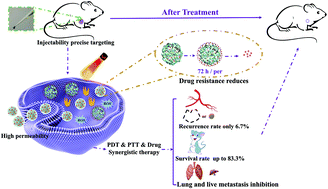An injectable and biodegradable nano-photothermal DNA hydrogel enhances penetration and efficacy of tumor therapy†
Abstract
The biological barrier of solid tumors hinders deep penetration of nanomedicine, constraining anticancer treatment. Moreover, the inherent multidrug resistance (MDR) of cancer tissues may further limit the efficacy of anti-tumor nanomedicine. We synthesized highly permeable, photothermal, injectable, and positively charged biodegradable nucleic acid hydrogel (DNA-gel) nanoparticles to deliver cancer drugs. The nanoparticles are derived from photothermal materials containing black phosphorus quantum dots (BPQDs). The intra-tumoral BPQDs improve the sensitivity of tumor cells to photothermal therapy (PTT) and photodynamic treatment (PDT). Tumor cells take up the positively charged and controllable size DNA-gel nanoparticles, facilitating easy penetration and translocation of the particles across and within the cells. Mouse models demonstrated the anti-tumor activity of the DNA gel nanoparticles in vivo. In particular, the DNA gel nanoparticles enhanced clearance of both small and large tumor masses. Just 20 days after treatment, the tumor masses had been cleared. Compared to DOX chemotherapy alone, the DNA-gel treatment also significantly reduced drug resistance and improved the overall survival of mice with orthotopic breast tumors (83.3%, 78 d). Therefore, DNA gel nanoparticles are safe and efficient supplements for cancer therapy.

- This article is part of the themed collection: Biomaterials Science Most Popular 2021


 Please wait while we load your content...
Please wait while we load your content...